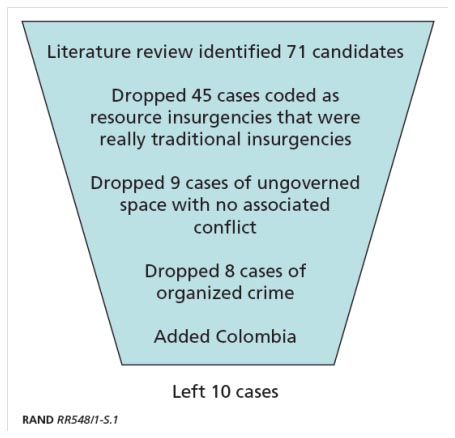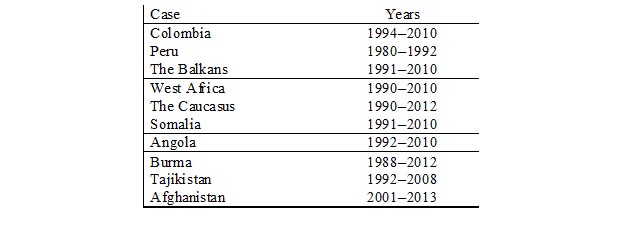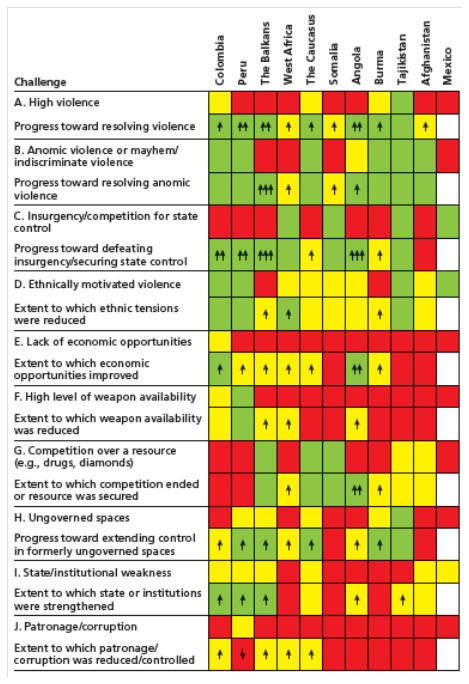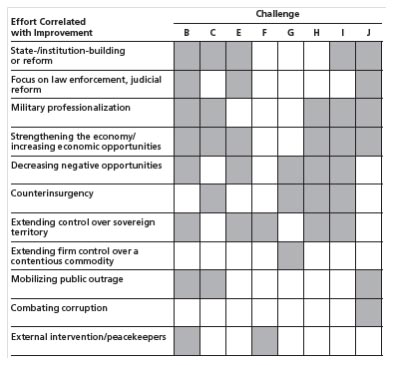Mexico Is Not Colombia: Seeking More Productive Analogies for Responding to the Challenge of Violent Drug-Trafficking Organizations
Christopher Paul, Colin P. Clarke, and Chad C. Serena
Abstract
Despite the scope of the threat to Mexico’s security, violent drug-trafficking organizations are not well understood, and optimal strategies to combat them have not been identified. Regions around the world have faced similar challenges and may hold lessons for Mexico. One point is clear, however: Mexico is not Colombia. In fact, Mexico is not particularly like any other historical case characterized by “warlordism,” resource insurgency, ungoverned spaces, and organized crime. Despite the lack of a perfectly analogous case, security policy in Mexico stands to benefit from historical lessons and efforts that were correlated with the greatest improvements in countries facing similar challenges. This article summarizes key findings from analyses comparing 10 different historical cases with Mexico.
Drug-related violence has become a very serious problem in Mexico. Violent drug-trafficking organizations (VDTOs) produce, transship, and deliver tens of billions of dollars worth of narcotics into the United States annually. The activities of VDTOs are not confined to drug trafficking; they extend to numerous other criminal enterprises, including human trafficking, weapon trafficking, kidnapping, money laundering, extortion, bribery, and racketeering. Then, there is the violence: Recent incidents have included assassinations of politicians and judges; attacks on rival organizations, associated civilians (i.e., the families of members of competing groups or of government officials), and the police and other security forces ; and seemingly random violence against innocent bystanders.
The full scope and details of the threat posed by VDTOs are not well understood, and optimal strategies to combat these organizations have not been identified. Furthermore, the associated security challenges are not confined to Mexico. Many are rooted in (or have spilled over into) neighboring countries, including the United States. Scholars often compare these security challenges with those faced by Colombia, but there are vocal critics of this approach. As indicated by the title of this article, we agree that Mexico is not Colombia. While certain characteristics of the Colombian case do provide useful lessons for Mexico, the historical record shows that security challenges (and their resolutions) from other times and places are also germane to contemporary Mexico and should not be overlooked. To more thoroughly and accurately examine the current security situation in Mexico, it is important to evaluate this historical record, identify the correct comparisons, and make the correct inferences based on those comparisons. In a recently published two volume RAND study, this is what we sought to do. The interested reader is referred to the full report (Mexico Is Not Colombia: Alternative Historical Analogies for Responding to the Challenge of Violent Drug-Trafficking Organizations) and to the companion volume of case studies (Mexico Is Not Colombia: Alternative Historical Analogies for Responding to the Challenge of Violent Drug-Trafficking Organizations — Supporting Case Studies). This short article summarizes the results of that larger research effort.[i]
The following key questions guided this research:
- What classes or categories of conflicts have characteristics in common with contemporary Mexican security challenges and thus might be good comparisons by being “like” Mexico?
- Which individual cases within those categories might be instructive comparisons?
- What specific challenges characterized those comparative cases, and which of those challenges does Mexico face?
- To what extent were those challenges resolved in the historical cases, and which of those solutions could provide useful lessons for Mexico?
- Ultimately, what can a range of different historical cases tell us about the prospects for and approaches to resolving Mexico’s security challenges?
Approach
Our principal approach to answering these questions involved conducting a series of historical case studies and comparing the challenges they faced (and the solutions they found) to the security situation in Mexico. We then assessed the extent to which Colombia is a good analogy for Mexico and evaluated the relative merits of the alternative comparisons.
Finding the Right Comparisons
Policy is routinely informed by historical analogy, and policymakers regularly seek to learn the lessons of history. In commenting on the misuse of history, Ernest May concludes that policymakers frequently do not “pause to analyze the case, test its fitness, or even ask in what ways it might be misleading.” He continues, “Seeing a trend running toward the present, they tend to assume that it will continue into the future, not stopping to consider what produced it or why a linear projection might prove to be mistaken.”[ii] In this context, the challenge is to identify the correct comparisons. If the violence that haunts Mexico is similar to the conflict that the Colombian government stared down, then Plan Colombia may indeed be a reasonable blueprint for dealing with Mexican VDTOs. However, if these two cases are qualitatively different (as we believe they are), then they would require at least partially different solutions. What, then, are the correct comparisons? What are the correct characterizations of the challenges posed by Mexico’s VDTOs, and which historical cases have the most in common with these contemporary challenges and can thus best inform an evaluation of Mexico’s policy options?
Colombia is often offered as an analog for Mexico,[iii] but it has also been derided as an inappropriate comparison.[iv] While Colombia certainly faced a challenge from VDTOs, both the circumstances and the threat differed from contemporary Mexico in several important ways: the nature of the perpetrators, territory, geography, targets, and tactics; the character of the violence; and the state’s ability to respond. For these reasons, we join critics in rejecting Colombia, by itself, as the most instructive analogy for Mexico.
Previous RAND research on Mexican security suggested three categories of cases with possible comparability or relevance to Mexico’s struggle against VDTOs: cases of warlordism or ungoverned territories, earnest efforts to combat organized crime, and “resource” insurgencies.[v]
Resource insurgencies are cases in which insurgents do not seek to win control of the state or establish their own government but simply to eliminate state interference with their exploitation of natural resources (such as diamonds, drugs, or timber). Cases of warlordism or ungoverned territories are similar to resource insurgencies, but in these instances the state does not sufficiently combat the rejection of its authority to earn the case the insurgency label. Whether or not they have become something more, Mexican VDTOs are certainly an instance of organized crime, so previous efforts to combat organized crime might provide fruitful analogies. Specifically, when governments have actively opposed organized crime in other places and times, what has proven effective, and what pitfalls have been encountered?
By examining selected cases of warlordism, ungoverned spaces, resource insurgencies, and efforts to combat organized crime, we can identify which cases are genuinely analogous to contemporary Mexico (and in what respects) and which approaches to meeting these security challenges have proven successful or unsuccessful.
Case Selection
Figure 1 outlines the case selection process that we used to identify the ten comparative cases. See the full report for a more detailed explanation of the process. Table 1 lists the ten selected cases.
Figure 1: Case Selection Process

Figure note: adapted from RAND RR-548/1 Figure S.1. Reprinted with permission.
Table 1: Cases Selected for Comparison with Mexico

Analytic Framework
Although all the cases have elements in common with Mexico and individually offer cautions, advice, or lessons for future Mexican security efforts, broad comparison remains somewhat tricky. We selected cases that fell into the four common categories mentioned earlier (warlordism, ungoverned spaces, resource insurgencies, and organized crime), but the detailed case studies (presented in detail in the second study volume) revealed a wide range of challenges and solutions. Thus, there is no simple way to take the combination of efforts that “solved Colombia” and compare them with the efforts that “solved the Balkans,” then extrapolate a recipe for success in Mexico. However, with a little extra nuance and complexity we were able to compare how similar challenges were addressed more or less effectively across the historical cases and, where Mexico faces those same challenges, infer which solutions might work (or are more or less feasible than others).
Table 2 lists ten challenges (designated A–J) that appeared in many of the historical cases. Mexico faces eight of these challenges. The columns in Table 2 represent the historical cases (with Mexico in the last column), while the rows of the table are paired. The upper row of each pair shows the extent of the challenge at the peak of the conflict, and the lower row shows the extent of improvement or progress toward addressing the challenge at the end of the case-study period, usually the end of the conflict. So, for example, the uppermost and leftmost cells of the table indicate that Colombia suffered from high levels of violence (challenge A) to a moderate extent (amber) at the peak of the conflict there, but violence improved moderately (↑, to green) by 2010.
Table 2: Challenges and Improvement in the Historical Cases

Table note: adapted from RAND RR-548/1 Table S.2. Reprinted with permission.
Table 2 also summarizes the comparative core of our analyses, showing which historical cases faced which challenges (and the extent of those challenges) in common with Mexico—and against which of those challenges each government made progress or failed to make progress—allowing us to thoughtfully identify instructive points of comparison.
Results and Conclusions
Mexico Is Not Colombia, Nor is It Any of The Other Cases
Through this research, we sought to identify the best possible comparative cases to use to make analogies to Mexico. We began with the observation that Mexico is not particularly analogous to Colombia, even though Colombia is the most frequently invoked comparison case. However, we are forced to conclude that none of the other cases we examined are much more analogous, and some are notably less so. That said, all the cases, including Colombia, share some important contextual commonalities and challenges with Mexico and thus provide useful lessons. The trick, then, is to isolate the aspects that provide the best opportunities for comparison and remain mindful of the differences. While there is not a single premium analogous case for Mexico, we identified several cases that should compete with Colombia as partial analogies in future policy discussions: Peru, the Balkans, West Africa, and the Caucasus. The remaining cases are much less analogous to Mexico but still provide lessons in discrete areas, even if their primary value is in serving as negative examples.
Lessons Highlighted in the Case Narratives
Each case study, regardless of whether it proved to be a particularly good comparison case for Mexico, offered some useful lessons, even if only as an example of what can happen if challenges like those faced by Mexico are allowed to run unchecked. Here, we summarize those lessons, with supporting cases listed in parentheses:
- Reform and improvement take time. (Colombia, the Balkans, Somalia, and Tajikistan)
- External supporters can really help. (Colombia, the Balkans, and West Africa)
- Improving governance and government capability can help address multiple challenges. (Colombia, West Africa, the Caucasus, and Afghanistan)
- Unity of effort among law enforcement and military forces is important. (Peru)
- Reducing ungoverned spaces by extending control and governance can help address multiple challenges. (Peru, the Caucasus, and Afghanistan)
- Improving social services and changing the economic opportunity structure can help decrease violence. (The Caucasus and Angola)
- Empowering locals can contribute positively to security. (Peru])
- Police reform can help reduce violence and support improved governance. (The Balkans, and Somalia)
- Effective efforts to fight organized crime balance both prevention and repression. (The Balkans)
- Prioritizing the most dangerous and violent organizations can help reduce violence. (West Africa)
- Co-optation of drug-trafficking organizations can work, but it can also have less attractive overall outcomes. (Burma)
- Corruption and poor economic conditions can exacerbate other challenges. (All cases)
Factors Contributing to Improvement in the Historical Cases
As part of the cross-case comparative analysis, we coded a number of factors related to strategies or efforts that were undertaken to mitigate challenges in the historical cases. We then examined the correlation between the presence of those efforts and progress toward resolving the selected challenges for cases in which a given challenge was present. Although the number of cases involved is small enough that we do not report specific correlation coefficients, Table 3 does indicate where we found a strong correlation between earnest efforts in an area and improvement toward resolving one of the challenges.[vi] Shaded cells indicate strong correlations.
Table 3: Efforts Consistently Correlated with Improvement in the Historical Cases

Table note: adapted from RAND RR-548/1 Table S.3. Reprinted with permission.
However, correlation is not causation. In many of these relationships, especially given the frequency with which individual challenges are correlated with multiple areas of effort, correlations could be spurious, with the relationship depending on some third factor. To hedge against this possibility and get closer to causation, we sought to use the narratives to confirm these relationships. For each relationship, we used the case narrative to test the sequence of the relationship (that is, to confirm that the purported cause did, in fact, come chronologically before the improvement in the challenge area). We then identified the extent to which the relationship contributed to the narrative explanation of the case, validating its presence as part of a plausible causal argument. Table 4 presents the results of this validation exercise.
Table 4: Efforts That Contributed to Improvement in the Historical Cases

As anticipated, several of the correlations observed proved to be spurious correlations in one or more of the cases, lagging improvement in one or more challenge areas rather than preceding it. Others, while present as correlations, were judged not to be important contributors to the resolution of challenges in a significant number of cases. Table 4 shows only those efforts that were confirmed as important contributors to improvement in the listed challenge areas in multiple cases. In the table, light green shading indicates that the effort was validated as contributing to improvement in some cases, while dark green shading indicates validation as a strong contributor.
Recommendations
Collectively, the historical narratives, the comparative analysis, consideration of the Mexican case in its own context, and a review of existing proposals and suggestions for Mexico in light of the lessons gleaned from the historical cases point to the following broad recommendations for Mexico’s government to consider in its efforts to address the country’s current security challenges:
- Focus efforts on the most violent of the VDTOs by both disincentivizing violence and removing the worst offenders.
-
Engage in government institution-building and reform, with specific focus on
- law enforcement and judicial reform
- extending control over (and government services to) all sovereign Mexican territory.
- Engage in proactive counterviolence efforts, including anti-mara (anti-gang) laws and alternative opportunities for current and potential members (e.g., education, training, employment).
- Investigate ways to better leverage public outrage, vet and selectively support citizen militias, and push law-enforcement reform to the local level to enable legitimate community policing.
- Measure and evaluate the state’s ability to control the use of force, enforce political decisions within sovereign territory, and repel attacks against security forces.
- Increase policymakers’ willingness to accept international support, especially from the United States.
Note that we are not the first to make these recommendations. However, the fact that our empirical research echoes them is a strong endorsement indeed.
End Notes
[i] The content of this article is copyrighted by RAND and published here with permission.
[ii] Ernest May, “Lessons” of the Past: The Use and Misuse of History in American Foreign Policy, New York: Oxford University Press, 1973, p. xi.
[iii] See, for example, June S. Beittel, Mexico’s Drug Trafficking Organizations: Source and Scope of the Rising Violence, Washington, D.C.: Congressional Research Service, January 7, 2011; Ted Galen Carpenter, Mexico Is Becoming the New Colombia, Washington, D.C.: Cato Institute, Foreign Policy Briefing No. 87, November 15, 2005; Vanda Felbab-Brown, The Violent Drug Market in Mexico and Lessons from Colombia, Washington, D.C.: Brookings Institution, Foreign Policy Paper No. 12, March 2009; Elyssa Pachico, “A Few Lessons from Colombia for Mexico,” Colombia Reports, May 24, 2010; and Rory Carroll, “Hillary Clinton: Mexican Drugs War Is Colombia-Style Insurgency,” The Guardian, September 9, 2010.
[iv] See, for example, Paul Rexton Kan and Phil Williams, “Afterword: Criminal Violence in Mexico—A Dissenting Analysis,” Small Wars and Insurgencies, Vol. 21, No. 1, March 2010; Renee G. Scherlen, “The ‘Colombianization’ of Mexico? The Evolving Mexican Drug War,” paper presented at the Southern Political Science Association Conference, New Orleans, La., January 7–10, 2009; Ken Ellingwood, “Why Mexico Is Not the New Colombia When It Comes to Drug Cartels,” Los Angeles Times, September 25, 2010; Kenneth Michel, Mexico and the Cocaine Epidemic: The New Colombia or a New Problem? thesis, Monterey, Calif.: Naval Postgraduate School, December 2010; Oxford Analytica, “Mexico/Colombia: Organized Crime Lessons Mislead,” January 20, 2011; and “Mexico Drug War Not Comparable to Colombia: Obama,” Reuters, September 10, 2010.
[v] Christopher Paul, Agnes Gereben Schaefer, and Colin P. Clarke, The Challenge of Violent Drug-Trafficking Organizations: An Assessment of Mexican Security Based on Existing RAND Research on Urban Unrest, Insurgency, and Defense-Sector Reform, Santa Monica, Calif.: RAND Corporation, MG-1125-OSD, 2011.
[vi] We coded many other factors that did not yield a correlation and thus are not reported in the table. Noteworthy in this regard are drug crop eradication efforts and specific strategies for dealing with an adversary (e.g., organizational decapitation efforts, focusing on groups one at a time, focusing on all groups simultaneously). This is not to suggest that those factors were not important in individual cases (indeed, the detailed case narratives suggest that some of these factors are important); they were not consistently correlated with improvement across the cases facing the challenges addressed in this study.
